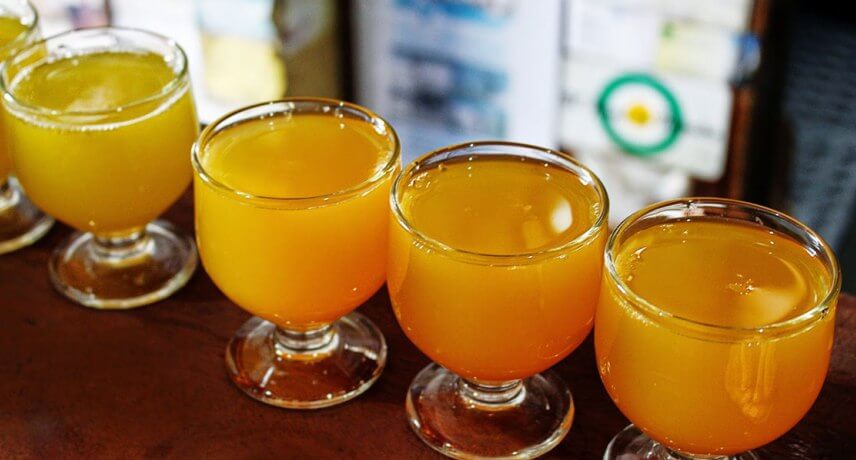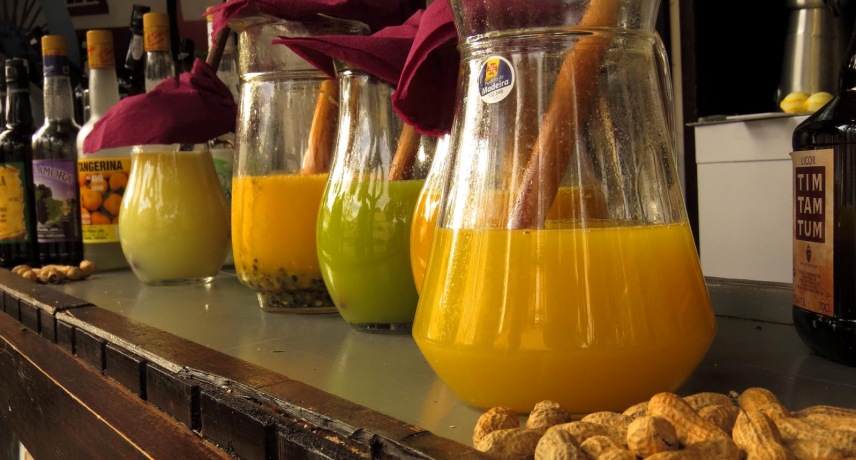Sat, 18 Dec 2021
How to make Poncha
Besides 'Madeira Rum', other ingredients are commonly used, namely honey and a variety of fruits produced exclusively in the region, such as oranges and lemons individually or even combined.
But it is important to emphasize that the brewing of this drink is not only in the ingredients that make it up, but also in the know-how passed on through generations, in which all this consists in combining the ingredients and adjusting their proportions. The main known ‘ponchas’ in Madeira are three, the passion fruit one, the regional and the ‘à pescador´’, which means fisherman.
Ingredients for regional ‘poncha’
- 2 lemons
- 2 oranges
- 1 & 1/2 tbsp white / brown sugar
- Bee honey
- Sugar Cane brandy from Madeira or «Rum»
"Regional Poncha" Preparation Steps:
-
In a tall glass place the lemon rind;
-
Add one and a half tablespoons of white or brown sugar and crush with a pestle;
-
Squeeze the juice of lemons and oranges;
-
Add the juice to the rind and sugar mixture. Mix with the ‘Mechelote’ (traditional Madeira island utensil to mix the ingredients). Strain the mixture into the jar.
-
Add sugarcane brandy (the same volume as orange and lemon juice). Add the honey with the ‘mechelote’ tool.
History of Poncha…
Madeira island is known for its vineyards which date back to the discovery of the island in 1419, by its liqueurs, the famous ‘rum’ or sugar cane brandy, a documented Madeiran heritage since the 16th century, but what really stands out is the Poncha!

Madeira Poncha is considered a traditional drink and has to be produced with an alcoholic drink named ‘Rum’.
This ‘rum’ drink is made from the finest selection of sugar cane and carefully distilled, and produced by the ‘Companhia dos Engenhos do Norte’, located in Porto da Cruz village, which dates back to 20th century. It stands out because of the medals it has received such as the International Spirits Challenge 2018, International Wine & Spirit Competition 2018, International ‘Rum’ Conference, Madrid.
Take a tour on this historic mill, and see how the factory machinery works, that takes us back to the time of the Industrial Revolution, where you can learn the living testimonies of the past sugar production on the Island. Go back to the early twentieth century, through the following links:
https://madeira.best/produto/passeio-de-jipe-ao-pico-do-areeiro-e-santana
https://madeira.best/produto/tour-do-este-da-madeira
We also suggest you visit the ‘Rum’ House right next to the Mill, where you can taste several ‘rums’.
Sugarcane was introduced in 1425 by Infante D. Henrique, it was imported from Sicily, and is an agricultural species of major importance to the history of Madeira, which originated the 'White Gold Age'.
This era came about because, in the 15th century, the island became a major supplier of sugar to other countries, and it is still used nowadays for 'Poncha da Madeira', and even for honey to make the famous 'Honey Cakes'.
Besides the Porto da Cruz mill, several small mills were built throughout the island, such as in Santana, Arco de São Jorge, Faial, Arco da Calheta, Serra de Água, Câmara de Lobos, among several others, of which there are no traces of today.
The first mill that ever existed in Madeira is believed to have been built in 1452 by Diogo Vaz de Teive, powered by water.
In 1883, 'Aluísio César Bettencourt' opened the Ribeiro Seco mill which is currently in operation, and in the village of Calheta founded in 1901, a period of great industrial development where at the time, its operations relied on a water-powered system but currently functions through steam power.
But it was in Funchal that the most important group of sugar and brandy production remained, namely around Santa Luzia’s, founded by William Hinton in 1845.

This mill is considered one of the oldest existing on the island, nowadays only its chimney remains in the Garden of Santa Luzia.
After the closure of the Hinton’s mill in 1985, only three mills remained on the island of Madeira, Ribeiro Seco, Porto da Cruz, and Calheta, which are still in operation, and even with a new one, called Novo Engenho da Madeira’ founded in 2006 located in Funchal, which follows the Hinton ancestors.
Ribeiro Seco - Endereço: R. das Maravilhas 170, 9000-167 Funchal - Website Link
Porto da Cruz - Endereço: Rua do Cais, Porto da Cruz - Website Link
Calheta - Endereço: Rua do Cais, Porto da Cruz - Website Link
Engenho Novo Engenho da Madeira - Endereço: 9370-221 Estreito da Calheta Parque Empresarial da Calheta - Website Link
"Poncha" Origin
The origin of the drink may be based on an Indian drink called «panche», as an adaptation brought from English travelers in the eighteenth century.
This drink has no known author or date. But it seems that the first ‘Poncha’ to emerge on the island was the same that is still known today, the ’Poncha à Pescador’, which was created by fishermen to warm themselves in the cold nights of Câmara de Lobos. The village is known as the 'fisherman's village' and it is assumed that it was in this place that the first ideas began for the use of tangerines or oranges to craft the drink.
Although this is a typical drink of Câmara de Lobos, ‘poncha’ is known and appreciated throughout the island, and the offer is multiplied in the old town of Funchal, Serra de Água, and Encumeada. It has also exceeded the borders of the Island itself and was taken across the Atlantic to Brazil, Africa, and the Caribbean.
Some say Càmara de Lobos is THE place to drink one of the best ‘ponchas’ in the region, in the traditional company of peanuts and lupins.
There are also versions of ‘poncha’ either in Brazil as caipirinha (made with cachaça, sugar, lime and ice), or in Cabo Verde, where it is called ‘grogue’.
Whatever the origin, 'Poncha' has, whoever goes to Madeira and doesn't drink ‘poncha’, didn't experience part of the Atlantic pearl's culture, after all, it's not just a drink, it has also become history that refers to the past years.
‘Poncha’ has become such a flagship product on the island that it is now, according to Regulation (EC) No 110/2008 of the European Parliament and of the Council of 15th January, a product of ''Protected Geographical Indication '', which means that it is a drink nationally recognized as being typical of Portugal, in order to protect the regional product and, above all, the local production of 'Rum'.
Changes over the years
The supposed original ‘poncha’ was a drink that fishermen drank to warm themselves on their way out to sea, which was made with sugar cane brandy, lemon peel, water, and sugar or honey. Nowadays, the drink no longer warms fishermen but is said to cure colds and other throat problems. 'Poncha da Madeira' has some flexibility in the selection of its ingredients, but the use of Madeira’s Rum is mandatory to be the original ‘poncha’. The remaining ingredients can be modified according to everyone’s taste, such as honey, citrus fruit, and sugar. Recently, many versions of ‘poncha’ have begun to emerge, with fruits, such as passion fruit, pitanga or tamarillo, mint, strawberry, kiwi, and other tropical fruits.

(Photo: Funchal Daily Photo from Paulo Camacho)
Unfortunately, some people began to lose their accuracy, introducing absinthe, whiskey, vodka and other spirits, and this introduction, appreciated by some consumers, raised a regional product identity problem.
But the great revolution of the ‘poncha’ in recent years has been the diversification of flavours, or the simple introduction of ice, that attenuated the intense flavour of the brandy.
However, from a strong, and taffy drink, ‘poncha’ has become a symbol of this island, where lemon is no longer the only fruit used and the softening of the taste has led to an increase in consumers, especially younger audiences and women.
Where should you taste Poncha?
Restaurant & Grill Muralha Terrace, Estrada Regional 220 nº1, 9350-217 Madeira, Ribeira Brava - Link
Taberna da Poncha, Serra d’Água - Endereço: Estrada Regional 104 nº329 9350-309 Ribeira Brava - Link
Mercearia da Poncha, Funchal - Endereço: Rua de Santa Maria, 154 9060-291 Funchal - Link
Venda Velha, Funchal - Endereço: Rua de Santa Maria 170 9060 Funchal - Link
Barreirinha, Funchal - Endereço: Largo do Socorro, n.º 1 9060-305 Funchal - Link
Mercearia do Bento, Funchal - Endereço: R. dos Tanoeiros 4, 9000-057 Funchal
FidyPoncha em Câmara de Lobos - Endereço: Caminho do estreitinho nº 1 Calvário- Estreito 9325 Câmara de Lobos - Link
As Vides, Câmara de Lobos - Endereço: Rua da Achada 17 9325 Estreito De Câmara De Lobos, Madeira - Link
Bar Arsénio, em Águas Mansas - Endereço: Águas mansas 9135 Santa Cruz (Madeira) - Link
Dino, Porto da Cruz - Endereço: Largo da Igreja 9225 Porto Da Cruz, Madeira, Portugal - Link
In case, you want to know more about the culture of Madeira, wines and Poncha with their tasting, you can book a tour with us:

